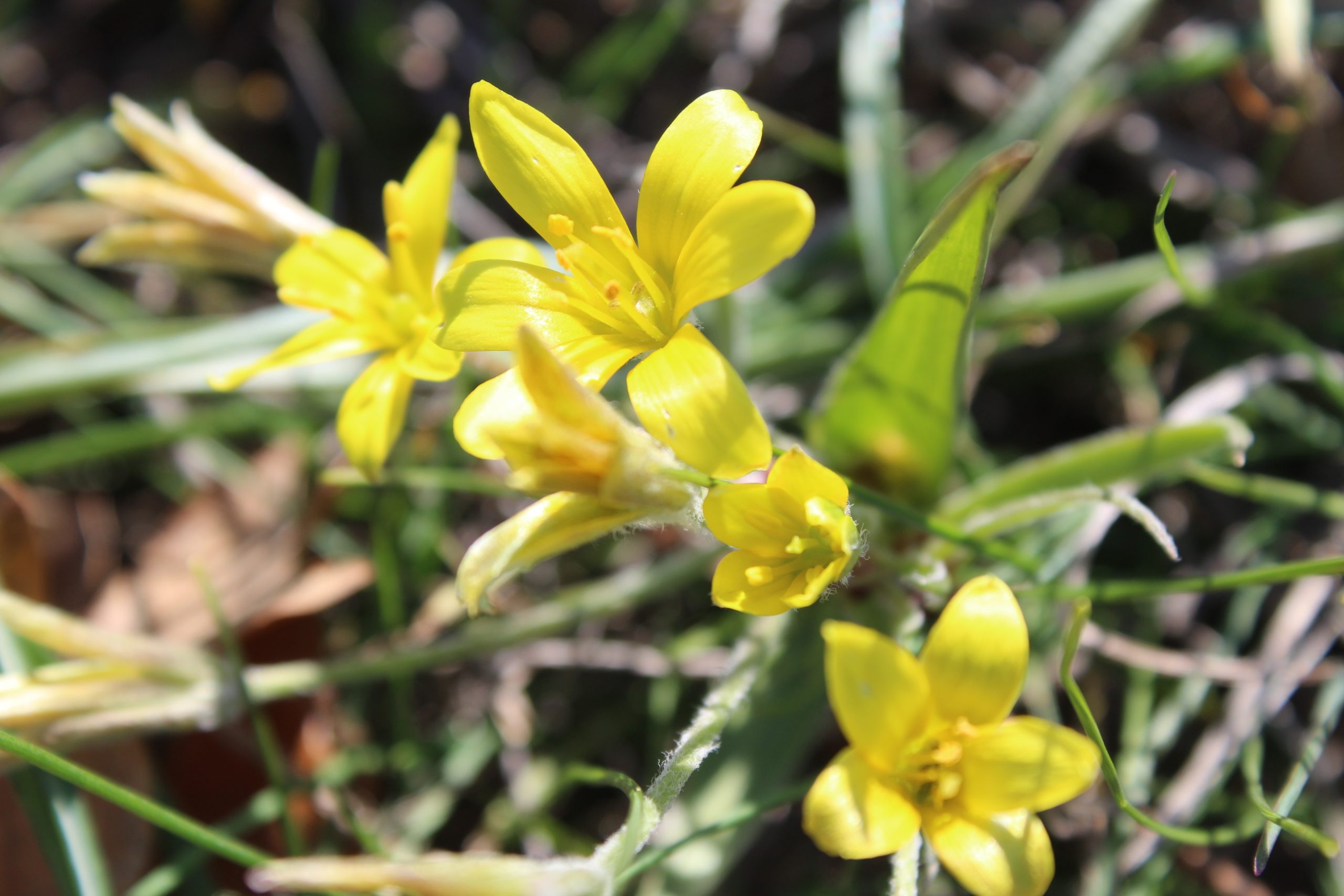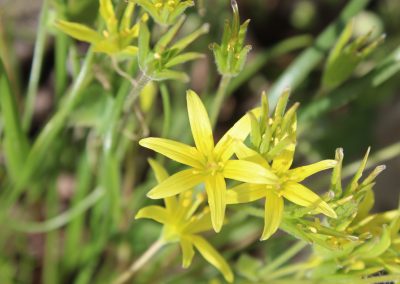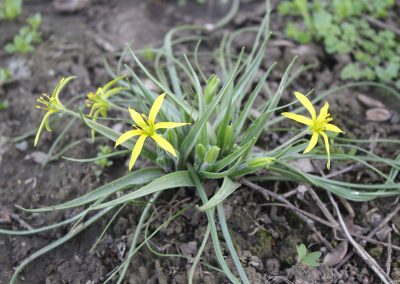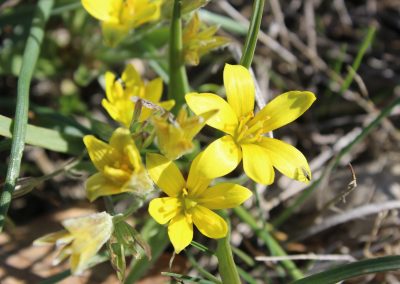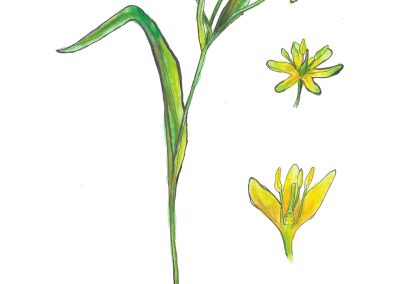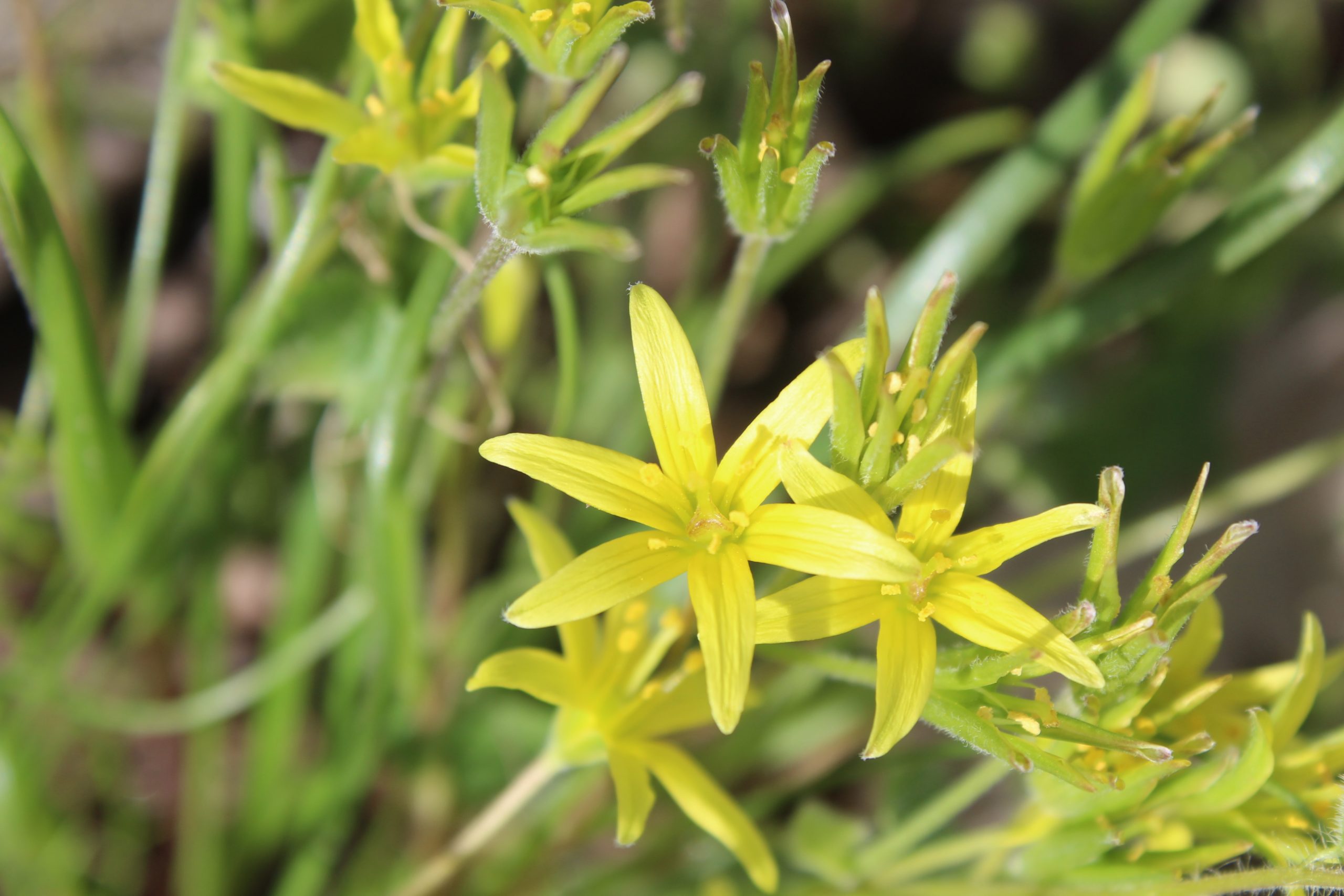Gagea Lutea
Scientific description
Taxon: Angiospermatophyta (Magnoliophyta)
Class: Monocotyledonatae (Liliatae)
Subclass: Liliidae
Order: Liliales
Family: Liliaceae
Origin: Eurasian
Common name: Snowdrop, Bethlehem Star
Description:
It is a herbaceous, perennial plant with a bulb. It reaches a height of 10–25 cm. The leaves are lanceolate, flat, with a hood-shaped tip. The flowers are yellow with greenish hues, about 1–5 per stem, arranged in terminal umbels, on a glabrous stem. The 1–2 cm long flowers are yellow, star-shaped, with 6 tepals, with 1–2 bracts that are not positioned over the flowers and are narrower than the leaves, with 6 stamens. It blooms in March and April. The fruit is a capsule with three compartments, containing multiple seeds.
Propagation: Bulbs and seeds.
Ecology:
Common from the steppe zone to the beech forest level, through meadows and shrubs. It prefers shady, moist areas.
Use:
It is planted in gardens and parks as a decorative plant in semi-shaded areas with clay-sandy soil.
Threat:
It is a species that is becoming increasingly rare near cities due to harvesting for its flowers.
Încrengătura: Angiospermatophyta (Magnoliophyta)
Clasa: Monocotyledonatae (Liliatae)
Subclasa: Liliidae
Ordinul: Liliales
Familia: Liliaceae
Origine: originară din zona euroasiatică
Denumire populară: laptele păsării, steaua galbenă din Betheleem
Descrierea:
Este o plantă erbacee, perenă, cu bulb. Are talie 10–25 cm. Frunzele sunt lanceolate, plate, cu vârful în formă de glugă. Florile sunt galbene cu nuanțe verzi, 1–5 pe o tulpină, dispuse în umbele terminale, pe o tulpină glabră. Florile sunt galbene, stelate, cu 6 tepale, cu 1–2 bractee care nu sunt așezate peste flori și sunt mai înguste decât frunzele, cu 6 stamine. Înflorește în martie și aprilie. Fructul este o capsulă cu trei compartimente, cu mai multe semințe.
Înmulțire: prin bulbi și semințe.
Ecologie:
Frecventă din zona de stepă până în etajul fagului, prin pajiști și tufărișuri. Preferă zonele umbroase și umede.
Utilizare:
Se plantează în grădini și parcuri ca plantă decorativă în zone semiumbrite, cu sol argilo-nisipos.
Pericol:
Este o specie care în apropierea orașelor este din ce în ce mai rară datorită recoltării pentru florile sale.
Γένος: Angiospermatophyta (Magnoliophyta)
Κατηγορία: Μονοκοτυλήδονα (Liliatae)
Υποκατηγορία: Liliidae
Τάξη: Liliales
Οικογένεια: Liliaceae
Καταγωγή: ενδημικό στην περιοχή της Ευρασίας
Δημοφιλής ονομασία: γάλα πουλιού, κίτρινο αστέρι της Βηθλεέμ
Περιγραφή:
Πρόκειται για ποώδες, πολυετές φυτό με βολβό. Έχει ύψος 10–25 cm. Τα φύλλα είναι λογχοειδή, επίπεδα, με άκρη σε σχήμα κουκούλας. Τα άνθη είναι κίτρινα με πράσινες αποχρώσεις, 1–5 ανά μίσχο, τοποθετημένα σε τερματικές ομπρέλες σε ένα γλαμπρό μίσχο. Τα άνθη είναι αστεροειδή, μήκους 1–2 cm, με 6 τεπάλια, με 1–2 βράκτια που δεν είναι τοποθετημένα πάνω από τα άνθη και είναι στενότερα από τα φύλλα, με 6 στήμονες. Ανθίζει Μάρτιο–Απρίλιο. Ο καρπός είναι κάψουλα τριών διαμερισμάτων με πολλούς σπόρους.
Πολλαπλασιασμός: με βολβούς και σπόρους.
Οικολογία:
Κοινό από τη στέπα έως τον οξιά, σε λιβάδια και θαμνώνες. Προτιμά τις σκιερές, υγρές περιοχές.
Χρήση:
Φυτεύεται σε κήπους και πάρκα ως καλλωπιστικό φυτό σε ημισκιερές περιοχές με αργιλοαμμώδες έδαφος.
Κίνδυνος:
Είναι ένα είδος που γίνεται όλο και πιο σπάνιο κοντά στις πόλεις λόγω της συλλογής των λουλουδιών του.
Taxon : Angiospermatophyta (Magnoliophyta)
Classe : Monocotylédones (Liliatae)
Sous-classe : Liliidae
Ordre : Liliales
Famille : Liliaceae
Origine : Eurasie
Nom commun : Perce-neige, étoile de Bethléem
Description :
C'est une plante herbacée vivace avec un bulbe. Elle atteint 10–25 cm de hauteur. Les feuilles sont lancéolées, plates, avec une pointe en forme de capuchon. Les fleurs sont jaunes avec des nuances verdâtres, 1–5 par tige, disposées en ombelles terminales sur une tige glabre. Les fleurs de 1–2 cm sont en forme d’étoile avec 6 tépales, avec 1–2 bractées qui ne sont pas situées au-dessus des fleurs et sont plus étroites que les feuilles, avec 6 étamines. Floraison en mars et avril. Le fruit est une capsule à trois compartiments contenant plusieurs graines.
Propagation : Bulbes et graines.
Écologie :
Commune de la zone steppique à l'étage de la hêtraie, à travers les prairies et arbustes. Préfère les zones ombragées et humides.
Utilisation :
Plantée dans les jardins et parcs comme plante décorative dans les zones semi-ombragées avec sol argilo-sableux.
Menace :
Espèce de plus en plus rare près des villes en raison de la récolte de ses fleurs.
Creative writing inspired by Gagea lutea
Written by Merve Sevdanur Meral
The Star That Waited
In a forgotten corner of the earth, where old forests whispered secrets before memory was born, there was one flower that flowered, said to have burst forth from a heavenly sign. It was called Star-of-Bethlehem by the folk, and they regarded it not as a plant, but as a living echo of a heavenly message of bygone years, and perhaps even a promise of things to come.
Legend spoke of the Holy Star, the radiant beam that guided wise men across deserts and mountain ranges to the lowly manger of a newborn king. But a little-known fact was that not all stars were abandoned in the skies. When its holy purpose was served, the Star wept, its heavenly glow so touched by the beauty of the Earth that it could not depart.
And thus, a solitary tear of starlight dropped, falling on the clean earth deep within a solitary forest. Where it touched earth, an old gold flower unfastened its petals at the dawning of the first spring—Gagea lutea. With its six star-pointed tepals shining like a small star, radiant with a gentle inner light even in the darkest of darknesses, it told tales of guidance, grace, and paths yet to be revealed.
In Slavic mythology, there was another tale whispered in whispers. They thought this golden flower bloomed every year to indicate the exact place where angels, during their heavenly wanderings, had once touched the ground. During Lent, villagers would look in silence for this modest flower, to possess it, being the sign of having been granted a vision—deceased loved ones, perhaps, or the awareness to know when overcome by severe bereavement. For this sacred reason, never was the flower picked; instead, it received silent prayer and reverence, the token of hope, not of ownership.
But as the years passed, towns expanded, and ancient roads were buried beneath the hard stone of progress, masking moss and memory beneath. The golden woods' stars glowed less brightly each year, their light not so sharp in the clamor of the growing world. But in hidden glades, beneath the watchful eyes of ancient trees, the Gagea lutea patiently awaits—neither flashy like daffodils nor snooty like roses, but steadfast. Waiting.
And perhaps, some day, when the world will be still once more, a weary heart will blunder into the quiet dappled coolness of a twisted old beech tree, and there it will be—glowing with a soft, ethereal light, the last star of Bethlehem, a gentle reminder that light, once given, is never truly lost.


